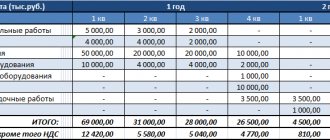Labour Organization
1. Appoint an effective manager. It must meet the following requirements:
- work experience, knowledge of the nuances of warehouse logistics;
- Confident user of PCs and process automation software;
- knowledge of all processes.
It’s good if such an effective manager can be “grown” independently from his employees. Isn't there such a possibility? Start your search on the side.
2. Monitor staffing levels. Do not exceed it unless absolutely necessary, but also do not go beyond the standardization of working hours for employees in accordance with current legislation.
3. When developing norms and local legal acts, be guided by the legislation: the Labor Code, Sanpin Regulations, current inter-industry norms and rules, federal laws, recommendations of various departments. Conduct workplace certification.
4. Develop a clear organizational structure for personnel. Over time, it can be modernized and new structural units or staff units introduced.
5. Regulate the work process so that staff have clear instructions for action. Develop and implement:
- Regulations on the warehouse (this will be your basis - the Constitution of the warehouse);
- regulations describing point-by-point the processes of acceptance, movement, storage, release, return, packaging, write-off;
- For each process, draw up a technological diagram;
- job and work instructions;
- instructions on labor protection, fire and electrical safety.
Monitor the validity period of the developed documentation.
6. Maintain the separation of labor and technological resources. They should be distributed evenly. A situation where one part of the warehouse is idle and the other is working hard is unacceptable!
7. Transfer workers to piecework-bonus payment.
8. Calculate salaries based on performance indicators (KPI). Take into account no more than 10 indicators, otherwise taking them into account will lead to even greater costs. You can limit yourself to taking into account the following indicators:
— volume of products shipped; — speed of shipment; — quality indicators (absence of fights, defects, accuracy of design).
9. Organize workplaces, equip them with everything necessary to perform job duties. Place the offices of immediate managers as close as possible to the work areas of subordinates.
10. Monitor the labor market in the field of warehouse logistics, track employment levels and changes in salaries.
Types of warehouses
To prepare a business plan for a warehouse complex, first determine its type. The choice is based not only on the wishes of the entrepreneur, but also on a preliminary study of demand. It is important to understand what kind of warehouse is required in the region. There are several classifications.
By purpose of use:
- Production. Raw materials and finished products are stored here. Such warehouses are most often built on or near enterprises to simplify logistics.
- Transit. They are located at transport interchanges, railway junctions, and near airports. Cargo is stored here for a short period of time, between loading onto other vehicles.
- Distribution and wholesale. Large quantities of goods are stored and distributed in several directions, for example, to several retail outlets.
- Customs. Designed for storing goods during clearance of transportation across the border. You can only open a customs warehouse directly near the border with another state.
- Retail. Used to store products from one retail outlet.
- Reserve. Designed to store stocks of raw materials and finished products until required.
- Responsible storage warehouse. A special variety that is not suitable for business. This designates the place of storage of goods that the buyer refuses for any reason. The cargo is stored there until the end of the proceedings.
By design:
- Closed. Traditional, fully enclosed hangars.
- Semi-closed. Premises protected by only 2 or 3 walls.
- Open. Areas adapted for storage, covered with an awning. The most unsafe.
By product type:
- Specialized. Designed to store only 1 type of product or raw material. For example, dairy products, meat, fish, shoes or clothing.
- Mixed. Products of related categories are stored here. For example, grocery, clothing, raw materials.
- Universal. Adapted for storing different types of products and raw materials.
The optimal solution for business would be a universal closed warehouse of production, transit or reserve type. A customs warehouse is also profitable, but it can only be opened at the border, which significantly reduces the number of potential entrepreneurs.
Warehouses are classified depending on their purpose, design and level of equipment
Western classification
In Western countries, it is customary to divide warehouses into classes from A to D, depending on area, purpose and other requirements. In Russia, such a classification is not established by law. But in practice, the letter description of warehouses is used quite widely:
- A+. This is the highest category, which includes rectangular one-story hangars made of especially strong light metals. Their height allows you to store products in 6-7 tiers. Equipped with ventilation, temperature control system, security system, video surveillance and fire extinguishing. The territory may have conference rooms, food outlets and other additional facilities that increase the comfort of users.
- A. The requirements for category are almost the same as A+, but differ in lower ceiling heights (at least 9 meters) and building materials (not only metal structures are allowed, but also sandwich panels.
- B. They are considered the best option in terms of price and quality of storage. Multi-storey buildings with ceilings from 4 to 8 meters. It is permissible to organize such a warehouse in a converted, rather than specially built, premises. Concrete and asphalt floors are allowed, heating and alarm are provided.
- C. Insulated hangars with ceilings from 4 meters. Any number of floors is allowed. At the zero level there should be a gate for the loader to enter inside. There must be an alarm system, a fire extinguishing system, and access control. Most warehouses in Russia belong to category C.
- D. Basements, hangars, basements and other industrial premises used for storage. Minimum requirements that differ in each individual case. They often work without heating, limited to a fire extinguishing system. Their only advantage is the low rental cost.
Unloading and receiving
11. Before you start unloading the vehicle, you must check the seal numbers with those indicated in the accompanying documents. Check their integrity and correct sealing. Inspect the vehicle for any malfunctions (rupture of the awning, broken lacing).
12. Develop regulations that determine the procedure for unloading vehicles if they arrive at the same time. Make the decision on priority based on the specifics of the arrived products and their quantity. First of all, it is advisable to unload items that will not be stored, but will go straight to packaging and shipping to the customer.
13. Unloading should be carried out rationally in accordance with the developed technological schemes. It is advisable to carry out unloading while simultaneously entering the goods into the register and controlling quantity and quality.
14. Only one type of product can be placed on a pallet. Avoid mixing and re-grading. You can set a rule that different items can be stored on one pallet, but only if they are sent to the same zone. Place packages so that labels are easy to read.
15. Pallets (pallets, stacks) used for storage must be stable, in good condition, and ensure the integrity of the goods during movement. To preserve the product, it is necessary to “palletize” it - wrap the top 2-3 rows with several layers of stretch film.
16. Unloading should be carried out as quickly as possible by the best workers.
17. Unload and accept for storage on the day of arrival.
18. Check compliance with the quantity specified in the technical specification by:
- partial or full weighing;
- recalculation of units in packaging;
- recalculation of the number of packages.
Be sure to open all suspicious or damaged packages to check the safety of the contents.
19. An effective method to increase the speed of unloading and registration is to assign certain categories to suppliers: “super reliable”, “reliable”, “requiring verification”, etc. There is no need to check cargo from a highly reliable supplier. A “reliable” supplier needs to check no more than 30% of the supply volume. Cargo from a supplier that “requires inspection” is checked thoroughly.
20. In case of detection of shortages, surpluses, mismatches, defects and other claims, draw up a report. You can use the unified form TORG-2, developed by Goskomstat, but it is very cumbersome. The law allows you to use your own approved form of the act.
Storage
21. Each product category must have its own zone. And in the warehouse management system, separate or so-called “virtual” warehouses must be created. For example, a warehouse “in the long-term storage area” or a warehouse “in the awaiting shipment area.” This way you will always know how goods are moving within the “physical” (main) warehouse.
22. Inside the designated area there must be a designated place (box, shelf, pallet, rack) for a specific item.
23. Frequently in demand goods should be easily accessible. Such items should be placed as close to the shipping area as possible. To determine demand, use ABC analysis or a special percentage of circulation method.
24. Sometimes the “rule of demand” has exceptions: large-sized goods, regardless of demand, are better stored nearby near the shipping area. It is advisable to store products of great value in the back of the room.
25. Determine the categories of goods for statistical storage - in allocated places, and for dynamic storage - place them in free places at the time of its receipt. Appoint employees responsible for organizing accommodation.
26. You cannot store goods on the floor! Use pallets of the same standard 800x1200, 1000x1200 or any other size.
27. Hand over the goods for storage as carefully as possible. Inspect it daily for integrity.
28. Enter the “3 steps” rule for a quick search: Step 1 - sort the products into groups. The staff will remember where this group is stored.
29. 2nd step - address storage (product in quantity “x” is stored in department “A”, on rack “B”, on shelf “1”, in cell “11”). Enter the information into the accounting system. Make the labels in different colors. The color will aid in identification.
30. 3rd step - implementation of an automated accounting system, use of bar codes, bar codes, digital codes, electronic tags. This method helps to set up work quickly and efficiently, but has disadvantages:
- high price;
- strict regulation of all actions;
- zoned storage only;
- availability of good software;
- It is necessary to train personnel to work with the system.
Choosing a warehouse management methodology
Nowadays, warehouse organization is often based on the address method. Addressed storage in a warehouse is very important where there is a large assortment of goods, which means we will focus on it. In address warehouses, goods are stored in cells that have their own unique number. At the same time, control over the movement of goods is significantly simplified, the route of its movement is optimized, and control over storage conditions is optimized. The use of automated warehouse complexes by default implies targeted storage, since the movement of goods is controlled by automatic manipulators without human intervention. A high level of automation can significantly increase operational efficiency with a slight increase in costs and expenses.
If an enterprise has several warehouses that are geographically separated, then it is possible to carry out intra-warehouse movements between them. This approach is often justified when it is difficult to forecast the dynamics of demand for storage services. Due to unbalanced demand, there are likely cases of shortage or excess of free space, which is quickly corrected by intra-warehouse transportation.
Inventory in the area of storage areas must be carried out without fail. The optimal frequency is at least once a month. This event is aimed at identifying facts of theft and shortcomings in the personnel management system (poor quality acceptance of goods, mismatches, errors in the quantity of goods in packaging, and other shortcomings).
The address warehouse is usually divided into three conventional zones. In the first zone, unloading work is carried out, initial sorting and determination of which storage zone the goods will be sent to in the future. The second zone is the place where goods are stored, placed in special storage cells. In this zone, everything is clearly divided into rows and pallets. Racks and shelves are clearly numbered. Each shelf is divided into several cells, which also have their own serial numbers. In the third zone, goods intended for shipment are assembled and sorted.
The main advantage of the address method is that to carry out operations at any stage, personnel need a minimum of information, since all address information of the product is written down in the documents. For example, during the acceptance of goods, the receipt document already contains the address where each type of goods must be specifically placed. And when completing an order, the employee is given an assembly sheet, where the addresses of the required goods are already clearly marked. At address warehouses, the influence of the human factor on the work process is minimized.
Picking and shipment
31. Never release cargo without accompanying documents. The ECAM warehouse management system allows you to generate waybills, invoices, TORG-12 and many other documents.
32. Develop picking routes, set deadlines for preparing accompanying documents.
33. Set the time for receiving applications from clients: for example, applications submitted after 16:00 are processed the next day, applications submitted before 12:00 are processed on the same day after 15:00, etc. Appoint an official who will be authorized to make decisions on changes to the picking time regulations.
34. Determine priority items for shipment. This:
- orders that will be delivered to the client earlier;
- orders for the last unloading point of the carrier vehicle.
35. It is reasonable to use a combination of two configuration methods:
- individual, when the required amount of goods for one order is withdrawn from departments;
- complex, when a product that is present in several orders is withdrawn.
Designate an employee who will decide on the picking method.
36. Place the assembled goods in a container, place it on a separate pallet, and wrap it with film. Label with the customer's name and delivery address.
37. Create a “Picking Log”, where each employee responsible for order picking will sign.
38. Inspect the vehicle for suitability for the load being transported. Do not ship to inappropriate vehicles.
39. Do not exceed the permitted carrying capacity of the vehicle or axle load.
40. Avoid bulk loading or placing heavy goods on top of light ones. If the product is damaged during shipment, replace it immediately - a return from the client is inevitable, but will cost more. Upon completion of loading, we seal the vehicle in accordance with the established regulations.
Who runs the warehouse?
The warehouse must be staffed with qualified staff, which includes:
- manager - someone who knows how to organize the work of subordinate employees, who is in charge of the dynamics of inventories in the warehouse, and is financially responsible for their safety;
- storekeeper - an employee who takes into account valuables in the warehouse: accepts and issues them in accordance with the accompanying documentation, maintains consumable documents, carries out re-accounting, etc.;
- loaders – move materials around the warehouse, to the enterprise and to transport;
- junior maintenance personnel - called upon to keep the warehouse clean.
Warehouse zoning
41. Determine what rooms you need based on the picture:
42. Divide the entire area of the room into zones.
34. The area of each zone must be used with maximum benefit, then it may turn out that part of the premises can be rented out.
44. Do not allow the storage area to spread to other departments.
45. Use a scientific approach to calculate the required area for each zone. The calculation is based on cargo turnover and inventory turnover indicators.
46. Create a “rejection” zone and place products there that do not meet the established requirements. It is advisable to clearly fence it off.
47. Let the manager submit a monthly report on products in the “reject” zone, proposing solutions for its further use.
48. Take measures to reduce the number of defects:
- price drop;
- bonuses for sales managers;
- promotions, sales;
- return to manufacturer;
- repair, restoration;
- selling to your employees;
- charity events;
- disposal.
49. The presence of passages and passages inside the warehouse is mandatory!
50. Administrative and utility premises must be in sufficient quantity: toilets, showers, locker rooms, rest rooms. The optimal norm is 3 sq. meters for 1 person.
Organization and improvement of warehouse operations
Organization of a warehouse and warehouse accounting includes work on the warehouse processes themselves, and also requires automation of routine processes. Let's try to figure out how to organize the work of a warehouse, automate processes, improve performance and get acquainted with some recommendations. Keep this list for yourself and note what work you have already completed and what remains to be done.
Expert Alexey Snegur talks about the most common problems in organizing a warehouse and solving critical situations in a warehouse.
Unloading and receiving
- Use regulations for orderly unloading, taking into account the specifics of goods, quantity, the need for packaging and dispatch time.
- Conduct unloading, simultaneously recording and controlling quantity/quality.
- Avoid mis-grading; labels should be easy to read.
- On the day of arrival, unload and take into storage.
- The quantity must correspond to that indicated on the invoice.
- Increasing the speed of unloading and registration is possible by assigning certain categories to suppliers: “most reliable”, “reliable”, “needs to be checked”, etc. - this way you can save time on checking the goods.
- Draw up an act in case of shortages, surpluses, mismatches.
Placement of goods after receipt must take into account weight and dimensional characteristics
Storage
- Allocation of specific zones for categories.
- Organize storage areas for SKUs within designated areas.
- The most popular goods should be in an area of easy access and located as close as possible to the shipping area. Demand can be determined using ABC analysis or by the number of requests.
- Store large items near the shipping area and valuable items in the back of the warehouse.
- Allocate space for goods for static storage; for dynamic storage, use free space at the time of receipt.
- Do not store the goods on the floor, inspect the integrity.
Correct placement of goods in the appropriate storage areas is the key to their availability when collecting orders.
Picking and shipment
- The cargo must be accompanied by accompanying documents.
- Process applications received before 12:00 on the same day.
- Ship according to priority.
- Combine several ways to complete your order.
- The vehicle's carrying capacity and axle load must match.
- Do not place a heavy product on top of a light one. If the item is damaged during shipment, please replace it immediately.
The speed and accuracy of selection and shipment of orders depends on the correctness of their placement in accordance with the chosen scheme (for example, address storage)
Warehouse zoning
- Divide the warehouse area into zones based on cargo turnover and inventory turnover.
- Use each warehouse area to its maximum benefit, rent out unused spaces.
- Create a “reject” area for products that do not meet established requirements.
- Ensure that aisles and passages inside the warehouse are wide enough.
Dividing the warehouse into zones allows you to assign responsibility for better control over the assortment of each zone
Order in the warehouse
51. Even if there is a significant lack of space, leave passages along the walls of at least 50 cm, this will make it possible to walk around the perimeter of the warehouse for inspection and during cleaning.
52. If there is not enough space, then consider the possibility of additional shelves on the racks, or adding mezzanines on top. Or maybe you can reduce the space between the shelves?
53. Do not store extraneous items in the warehouse.
54. Use a modern lighting system. Paint the ceiling a light color - this increases the luminous flux.
55. Create a lighting system that will illuminate only those parts that need to be illuminated at the moment. This will significantly reduce energy costs.
56. Use the principles of ergonomics: light-colored walls and ceilings will visually increase the space. Use bright colors to highlight hazardous areas.
57. Apply markings on the floor for the movement of equipment. Mark its parking spots.
58. Equip the warehouse with warning signs and information boards. Be sure to hang a sign with safety information.
59. Keep it clean. Carry out systematic cleaning and deratization. Make sure all systems are in good working order: sewerage, ventilation, air conditioning.
60. Please note that your warehouse will be known far beyond your region - carriers willingly share information about working conditions.
Important advice when organizing warehouse work in the first stages
If work is just getting started, pay more attention to feedback from clients and employees. Take into account all wishes, grievances and any information from people. Periodically arrange surveys for employees (can be anonymous), from which it will become clear which parts of the warehouse require attention, which processes are not ideal.
Do not neglect the participation of specialists in narrow fields. As a rule, their help allows you to significantly reduce preparation time and achieve the necessary results at the very beginning of work.
Warehouse equipment
61. Loading and unloading equipment is very expensive. It is better to calculate the required quantity using the well-known Gadzhinsky method. It is important to correctly calculate the stock indicator: when a certain number of carts during unloading can be supplemented with idle ones from a neighboring department.
62. Each piece of equipment must be assigned to a specific person - individual responsibility increases its service life many times over.
63. The technical department should have everything necessary for maintenance: brushes, rags, a vacuum cleaner, buckets. Lubrication and maintenance materials should also be available and located in the technical department.
64. Please note that employees working with complex equipment are required to undergo training. To conduct training, you must enter into a contract with the training organization.
65. Has the warranty period expired? Carry out an inspection on the basis of which you can decide on the advisability of further use, sale, or purchase of new equipment.
66. Try to purchase from one manufacturer. Spare parts from decommissioned equipment are suitable for repair.
67. The entry of equipment into a carriage or vehicle body is justified. Use overpasses and control bridges for this.
68. When choosing a manufacturer, consider:
- cost, payment terms;
- lifetime;
- reviews from other buyers;
- specifications;
- How is service organized?
69. On a level floor, use wheels with a polyurethane coating. For uneven earthen floors or asphalt surfaces, use rubber wheels or nylon rollers.
70. Buy 80% hydraulic trolleys with two rollers - to work along the entire length of the pallet. 20% of trolleys with one roller are enough for working with a pallet from the side.
Cost reduction, optimal budgeting
71. Manage the cost of operations, which is calculated as the dependence of processing costs on cargo turnover over a period of time. Cost data will allow you to see ways to optimize technological processes.
72. Make the cost indicator the main motivation of management personnel: the lower it is, the more bonuses.
73. If possible, determine the cost of each operation - this will help to identify and eliminate unnecessary ones that are not profitable.
74. To reduce costs, implement IT technologies and lean principles.
75. Reduce the number of manual operations involved in moving loads to the minimum possible. Labor productivity will increase - costs will decrease.
76. Increase the level of staff training. Create a flexible motivation system.
77. Approve standards for consumables. Review them periodically.
78. Make a budget in advance - this will allow you to spend money efficiently.
79. Give the manager some financial independence: let him decide on the priority of payments.
80. Remember! The warehouse doesn't spend money, it earns it! There are many ways:
Safety of material assets
81. Conclude a liability agreement with each employee.
82. Demand that staff strictly adhere to established rules, norms, and regulations.
83. Do not allow a “peak” load on the warehouse, this leads to different results in fact and documentation.
84. Employees should know that losses are covered from the company’s net profit.
85. Do not punish anyone financially without establishing the reasons and conditions for the shortage (damage to products).
86. Eliminate the possibility of theft of goods or the presence of strangers.
87. Special control is required in shipping areas - this is where 90% of thefts occur.
88. Pay staff salaries on time.
89. Periodically check employees for alcohol intoxication and drug addiction.
90. Use modern security systems or at least dummies of them.
Managing a warehouse. Note to warehouse manager Andrey Baturov
The timely execution of orders, uninterrupted work in the workshops and the reputation of the entire company depend on how work is organized in the warehouse. Whatever it is, no matter what products are stored here, its function remains unchanged: a warehouse is a buffer designed to harmonize the capacities of sites, production and sales, combined with an area for processing inventory, where goods change shape, completeness, condition etc.
The visible basic elements of the warehouse system, constantly in interaction, are:
staff;
equipment;
inventory items.
Do not forget that there are other elements involved in the operation of the system:
processes;
document flow and accounting system;
organization of work.
Let's deal with each of them in turn.
When, upon entering a warehouse, we observe busy work - some workers unload goods, others load them, others move them around the warehouse, others draw up documentation, some manage, some carry out - we involuntarily create the illusion that everything is going as it should. , work is in full swing, and everyone is busy. But vanity is not an indicator of effectiveness. Quite the contrary - it is evidence that this warehouse “organism” is sick and needs urgent treatment.
In a normally organized and managed warehouse system, by definition, there cannot be a concentration of personnel and processes in one place and at one time. In well-organized warehouses there is peace and quiet, work is carried out in a measured manner, there are no crowds of employees here - only solitary workers, slowly and without distractions, do their job.
Let's try to take a closer look at what is actually hidden behind the “active” life of the warehouse described above, and determine the possible reasons for the rush and turmoil that often arise, which we often perceive as a natural state of affairs:
The presence of material crosses and intersecting material flows indicates improper space planning and irrational distribution of work, which increases the possibility of errors and the risk that goods will be sent to the wrong destination.
The presence of technological crosses, intersecting routes of movement of equipment and people, leads to slowdown of work and increases the risk of damage (to both equipment and employees).
Lack of proper planning of warehouse operations (performing work as the need arises) leads to the fact that planned operations overlap in time and space, creating a load on the same elements of the warehouse system.
The inefficiency of the shift organization of work occurs when the load on the warehouse is assessed by average indicators (per week, day) and the shift organization of work does not take into account the real peaks in the load on processes and operations.
Ineffective organization of work - when the line manager does not know what, who should do and when, employees make these decisions on their own, which, in the absence of an organization and a “command center,” ultimately turns out to be disastrous for any system.
These are the simplest, but at the same time the most global problems of the warehouse, which immediately catch the eye when carefully observing how the work is carried out.
Let's dwell on some elements of the working atmosphere of the warehouse and consider them in more detail.
Inventory
The simplest step when conducting a “audit with your own eyes” is to monitor the condition, circulation, storage and movement of inventory items.
In relation to inventory items, we can identify a group of simple signs of the existence of problems in the warehouse system:
Inventory and materials are located in a warehouse outside the system of logistics units (box, pallet, container, etc.);
Inventory and materials are stored directly on the floor without reference to any zone (identified according to the accounting system);
sales packaging or storage (movement) unit of goods and materials are damaged;
Inventory items are in the warehouse without any packaging;
Inventory and materials are located in a warehouse without an identification system (identification is carried out by appearance or is difficult);
Inventory materials are in packaging, in a logistics unit, but in a form that makes them impossible to process without additional costs and operations.
The presence of such problems in the warehouse allows us to draw disappointing conclusions:
the warehouse does not have a storage system;
rules for working with inventory items have not been developed or not brought to the attention of employees;
Warehouse workers do not comply with the rules for working with inventory items;
the warehouse has not implemented an accounting system or its implementation is impossible;
the level of performance discipline and organization of work in the warehouse is low;
the level of balances in the accounting system never corresponds to the actual level;
Additional costs are constantly required for rejection, repackaging, purchasing packaging materials, etc.
There are frequent cases when, at the time of submitting a request, inventory materials are not ready for shipment, which leads to an increase in order fulfillment time or its failure. Because if, for example, out of 10,000 boxes, 50 are damaged, lost or unpacked, the order cannot be considered fully completed. In any case, the result will be additional costs and disruption of the order.
the problem of lack of people, equipment and space will arise regularly, since part of the resources is constantly directed towards additional operations.
The worst thing for an enterprise in such a situation is not even the loss of profit from a failed order or wasted time. It is much worse if warehouse workers (loaders, storekeepers, warehouse manager, logisticians), faced with these failures and their consequences every day, do not notice them, considering everything that is happening NORMAL. In this case, the problem is not some part lying on the floor; the problem is much deeper and its solution will require changing the entire system and, possibly, replacing many employees.











